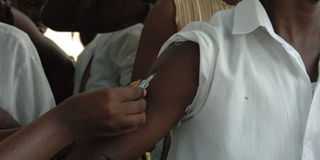Expensive diagnostic services and drugs undermines Hepatitis B fight

What you need to know:
Uganda joined the rest of the world to commemorate World Hepatitis Day on Thursday last week as patients continue to decry inadequate diagnosis and high treatment costs
About 3.5 million people are living with viral Hepatitis B in Uganda. Unfortunately, most sufferers are unaware they have the disease, with Karamoja sub-region having the highest prevalence rate of 23.9 per cent.
As the country readies itself to eliminate the disease by 2030 as endorsed by World Health Organisation, the fight remains hobbled with limited awareness, inadequate screening services and unavailability of treatment for those who test positive.
Uganda needs to address the challenges hindering the Hepatitis B interventions if it’s to meet the deadline.
In an interview with Daily Monitor, the executive director of the National Organization for People Living with Hepatitis B, Kenneth Kabagambe who is a patient himself, says: “… we need equal access to healthcare, patients should be put at the centre of any programme because they are the ones who need it.” He adds that much as the focus has been on vaccination, the government should also focus on providing drugs for those who are positive.
Lack of screening services and drugs
Unlike HIV/Aids which has designated treatment and care points across the country, Hepatitis B lacks a proper referral system for patients.
Testing has stages, and for those who test and are positive, they need to do further tests. This is in addition to the assessment tests, which determine whether an individual needs treatment or not.
He adds that a patient spends about Shs400, 000 on tests which is expensive, with some patients opting for alternative herbal medicine.
Despite a local company (Cipla Quality Chemicals Industries) manufacturing the Hepatitis B drugs, Kabagembe says patients are unable to access drugs.
However, the chief executive officer of CiplaQCI, Nevin Bradford says their warehouse has antiviral drugs recommended for Hepatitis B treatment.
“We are waiting for the Ministry of Health to avail funds to the National Medical Stores (NMS) to have the medicines supplied to those who are in need,” Bradford says.
Naveen Sukumaran, the CiplaQCI manager says the cost for a one month’s dose of Hepatitis B drugs is Shs35,000.
“Going forward, there are not going to be challenges with medicines because government has a clear plan to purchase drugs for treatment,” says Sukumaram, adding that increased investment in laboratory services will also reduce the cost of treatment.
Dr Amandua Jacinto, the commissioner of clinical services at the Ministry of Health, says government is in advanced stages of purchasing drugs for patients who need treatment. It is expected to spend about $7 (Shs23,674) per dose.
The ministry was allocated Shs10b in this year’s budget to cater for Hepatitis B. However, it is not clear whether some of the funds are going to be spent on drugs.
Citing WHO guidelines, Dr Amandua says only few patients currently meet the treatment criteria, and not every person who tests positive for Hepatitis B virus needs treatment. “The surface antigen test in public health facilities is free and the viral load test for Hepatitis B is not necessary,” he adds.
“The most important message from this World Hepatitis Day is that we must test and create awareness.”
Dr Amandua observes that most of the health facilities in the country are able to screen for Hepatitis B. He says that using an AST to platelet Ration Index formula, any clinician can be able to tell whether a liver has a problem or not.
In Kampala, there is a Hepatitis B clinic at Mulago every Wednesday but it has been shifted to Kiruddu General Hospital, adding that other treatment centres have been opened in Lira, Adjumani and Arua.
Vaccination
Government is conducting a vaccination campaign in 12 districts: Adjumani, Gulu, Dokolo, Moroto, Ngora, Lira, Moyo, Napak, Koboko, Kumi, Tororo and Arua.
According to Amandua, about 1.8 million doses of the Hepatitis B vaccine have been distributed. An individual is supposed to receive three doses.
Hepatitis B transmission
According to a pocket guide developed by the Uganda Gastroenterology Society (UGES) on care and treatment for Hepatitis B, the disease spreads through exposure to infected blood and various body fluids such as menstrual, vaginal, and seminaL fluids.
The guide indicates that it can spread from an infected mother to the baby during childbirth.
Dr Betty Apica, a specialised physician, says the virus can also be spread through blood transfusion, mostly occult hepatitis B which presents in the DNA, and not the surface antigen.
Dr Apica said Occult hepatitis B is hard to diagnose and can easily be transmitted to another individual through blood transfusion.
Stigma
Hepatitis B patients in Uganda are also grappling with stigma which Kabagambe says is higher than that experienced by HIV/Aids patients.
Prevention
While speaking at a symposium held on Friday last week, Prof Ponsiano Ocama, the President of UGES, said to control Hepatitis in all its forms A, B,C, D and E, the government needs to put people who are infected on care and treatment, strengthen childhood vaccination and sensitize the population.
“People still think that if you greet someone, you will get infected with Hepatitis B,” Prof Ocama says.
However, he says Hepatitis does not spread through greeting, sharing food, water or clothes.
“Persons who are infected should not be isolated on the basis of this infection not even at school,” Prof Ocama says.
Who is at risk?
These include household and sexual contacts of a person who is positive, HIV infected persons, persons who inject drugs, sex workers, recipients of blood and blood products and persons living in endemic areas such as Uganda.
prevalence rate
According to the Ministry of Health, Uganda is a highly endemic country with a 10 per cent national prevalence of hepatitis B infection. However, the rates vary across the country from four per cent in the southwest to 25 per cent in the Northeast.
Karamoja is the most afflicted region; standing at 23.9 per cent, followed by Northern Uganda 20 per cent, West Nile 18 per cent, Rwenzori region 10 per cent, Eastern region 7.1 per cent, Kampala 5.3 per cent, and the South Western region at 3.8 per cent.




